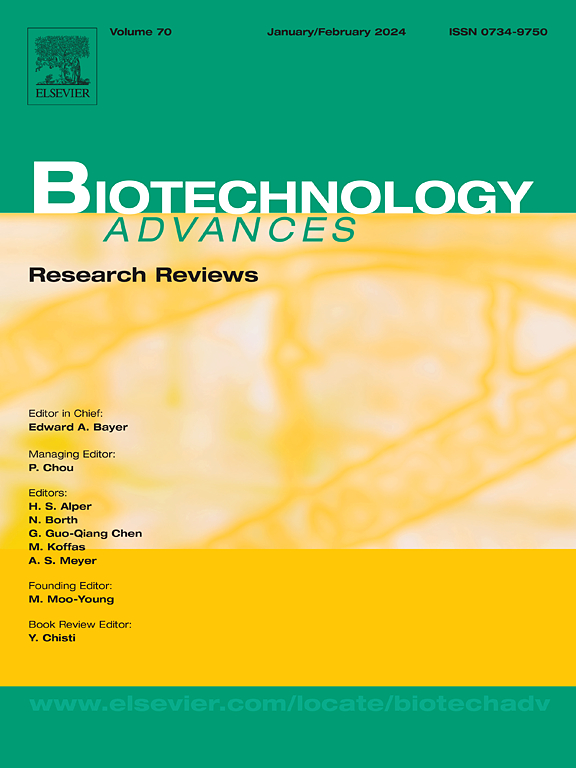Selecting optimal algal strains for robust photosynthetic upgrading of biogas under temperate oceanic climates
IF 12.1
1区 工程技术
Q1 BIOTECHNOLOGY & APPLIED MICROBIOLOGY
引用次数: 0
Abstract
Biogas generated from anaerobic digestion can be upgraded to biomethane by photosynthetic biogas upgrading, using CO2 as a bioresource for algal (cyanobacteria and microalgae) cultivation. This allows the upgrading technology to offer economic and environmental benefits to conventional physiochemical upgrading techniques (which can be energy-intensive and costly) by co-generating biomethane with high-value biomass. However, a critical challenge in implementing this technology in temperate oceanic climatic conditions (as found in Japan, and the northwest coasts of Europe and of North America, with average temperatures ranging between 5 and 20 °C) is the selection of algal strains that must be capable of sustained growth under lower ambient temperatures. Accordingly, this paper investigated the selection of algae that met seven key criteria: optimal growth at high pH (9–11); at alkalinity of 1.5–2.5 g inorganic carbon per litre; operation at low temperature (5–20 °C); tolerance to high CO2 concentrations (above 20 %); capability for mixotrophic cultivation; ability to accumulate high-value metabolites such as photosynthetic pigments and bioactive fatty acids; and ease of harvesting. Of the twenty-six algal species assessed and ranked using a Pugh Matrix, Anabaena sp. and Phormidium sp. were assessed as the most favourable species, followed by Oscillatoria sp., Spirulina subsalsa, and Leptolyngbya sp. Adaptive laboratory evolution together with manipulation of abiotic factors could be effectively utilised to increase the efficiency and economic feasibility of the use of the selected strain in a photosynthetic biogas upgrading system, through improvement of growth and yield of high-value compounds.

在温带海洋性气候条件下,选择最优海藻菌株对沼气进行强大的光合作用升级
厌氧消化产生的沼气可以通过光合沼气升级,利用二氧化碳作为藻类(蓝藻和微藻)培养的生物资源,升级为生物甲烷。这使得升级技术能够通过与高价值生物质共同生产生物甲烷,为传统的物理化学升级技术(可能是能源密集型和昂贵的)提供经济和环境效益。然而,在温带海洋气候条件下(如日本、欧洲西北海岸和北美,平均温度在5至20°C之间)实施这项技术的一个关键挑战是选择必须能够在较低环境温度下持续生长的藻类菌株。因此,本文研究了满足7个关键标准的藻类选择:高pH(9-11)下的最佳生长;碱度为每升1.5-2.5克无机碳;低温操作(5-20℃);对高浓度二氧化碳(20%以上)的耐受性;混合营养栽培能力;能够积累高价值的代谢物,如光合色素和生物活性脂肪酸;而且易于收割。在使用Pugh矩阵评估和排名的26种藻类中,Anabaena sp.和Phormidium sp.被评估为最有利的物种,其次是Oscillatoria sp., Spirulina subsalsa和leptolybya sp.。适应性实验室进化和非生物因素的操纵可以有效地提高所选菌株在光合沼气升级系统中使用的效率和经济可行性。通过提高高价值化合物的生长和产量。
本文章由计算机程序翻译,如有差异,请以英文原文为准。
求助全文
约1分钟内获得全文
求助全文
来源期刊

Biotechnology advances
工程技术-生物工程与应用微生物
CiteScore
25.50
自引率
2.50%
发文量
167
审稿时长
37 days
期刊介绍:
Biotechnology Advances is a comprehensive review journal that covers all aspects of the multidisciplinary field of biotechnology. The journal focuses on biotechnology principles and their applications in various industries, agriculture, medicine, environmental concerns, and regulatory issues. It publishes authoritative articles that highlight current developments and future trends in the field of biotechnology. The journal invites submissions of manuscripts that are relevant and appropriate. It targets a wide audience, including scientists, engineers, students, instructors, researchers, practitioners, managers, governments, and other stakeholders in the field. Additionally, special issues are published based on selected presentations from recent relevant conferences in collaboration with the organizations hosting those conferences.
 求助内容:
求助内容: 应助结果提醒方式:
应助结果提醒方式:


